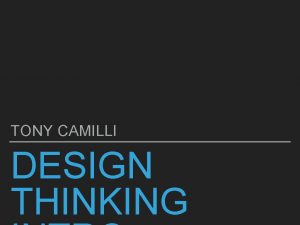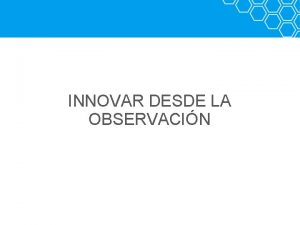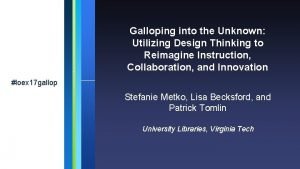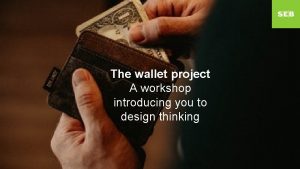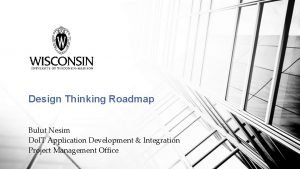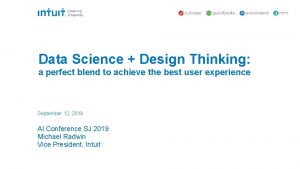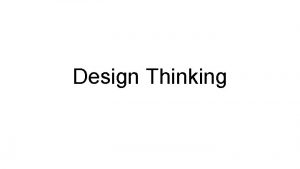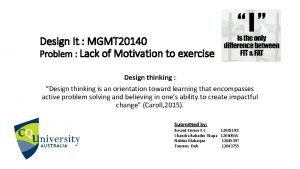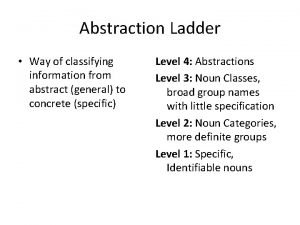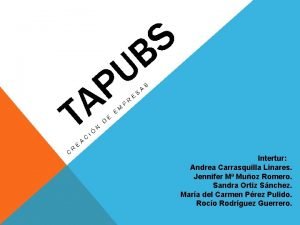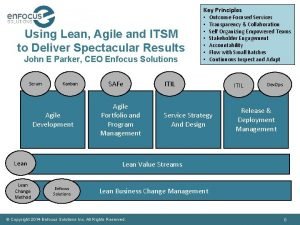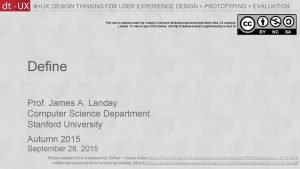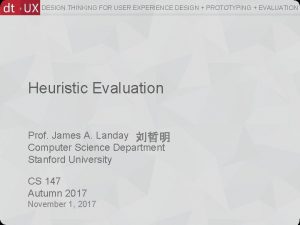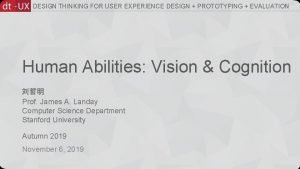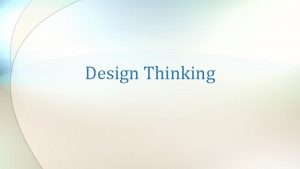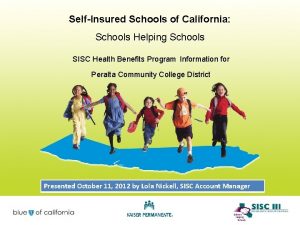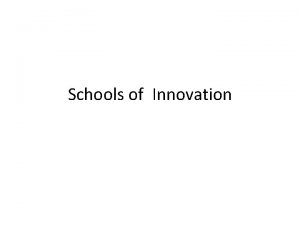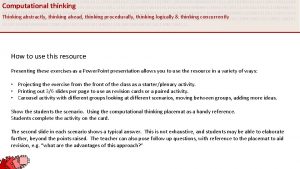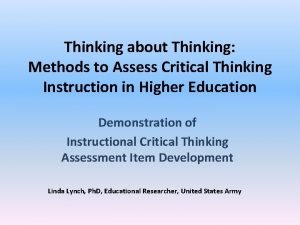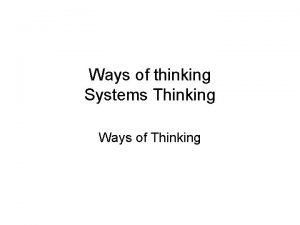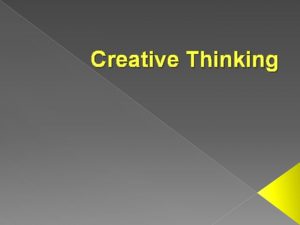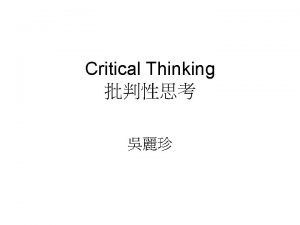Taking design thinking to schools Taking design thinking






















- Slides: 22

Taking design thinking to schools

Taking design thinking to schools Taking Design Thinking to School is a collaboration of the Hasso Plattner Institute of Design (d. school), the School of Education (SUSE) and teachers in local schools to explore how design thinking can best impact teaching and learning. The project moves from a pilot phase to an implementation and research phase that will help teachers prepare to bring the design learning process to more K-12 students. At its core bringing design thinking to K-12 is an issue of equity. Through design, children learn that they have power to change the world. They are the bread and butter supplementary experiences that students at the best schools are getting, yet public school teachers find them difficult to conceive of while they are under so much accountability pressure. This project aims to help teachers learn about design, see its value, and have the confidence to bring it to their classrooms.

what is design thinking? Design Thinking is an approach to learning that focuses on developing students’ creative confidence. Teachers and students engage in hands-on design challenges that focus on developing empathy, promoting a bias toward action, encouraging ideation, developing metacognitive awareness and fostering active problem solving. Using one’s imagination is central. . .

the design thinking process

UNDERSTAND Understanding is the first phase of the design thinking process. During this phase, students immerse themselves in learning. They talk to experts and conduct research. The goal is to develop background knowledge through these experiences. They use their developing understandings as a springboard as they begin to address design challenges.

OBSERVE Students become keen people watchers in the observation phase of the design thinking process. They watch how people behave and interact and they observe physical spaces and places. They talk to people about what they are doing, ask questions and reflect on what they see. The understanding and observation phases of design thinking help students develop a sense of empathy.

POINT OF VIEW In this phase of design thinking, students the focus is on becoming aware of peoples’ needs and developing insights. The phrase “How might we. . ” is often used to define a point of view. This statement ends with a suggestion about how to make changes that will have an impact on peoples’ experiences.

IDEATE Ideating is a critical component of design thinking. Students are challenged to brainstorm a myriad of ideas and to suspend judgment. No idea is to far-fetched and no one’s ideas are rejected. Ideating is all about creativity and fun.

PROTOTYPE Prototyping is a rough and rapid portion of the design process. A prototype can be a sketch, model, or a cardboard box. It is a way to convey an idea quickly. Students learn that it is better to fail early and often as they create prototypes.

TEST Testing is part of an iterative process that provides students with feedback. The purpose of testing is to learn what works and what doesn’t, and then iterate. This means going back to your prototype and modifying it based on feedback. Testing ensures that students learn what works and what doesn’t work for their users.

about our project Taking Design Thinking to School focuses on critical areas that will impact the world of 21 st century education. (1) professional development with teachers (2) development and adaptation of curriculum with design (3) development of assessments for research, evaluation and classroom use (4) opportunities for Stanford students to participate and conduct research in K-12 education settings (5)scale and dissemination efforts

CURRICULUM. . . ASSESSMENT. . . our stories LEARNING COMMUNITIES. . . LEARNING. . . CREATIVITY. . . IMAGINATION. . .

professional development

We brought teachers together for a two-day workshop to delve into the design process. Their challenge: “HOW MIGHT WE REDESIGN THE FRIDAY NIGHT EXPERIENCE IN DOWNTOWN PALO ALTO GIVEN THE CURRENT ECONOMIC CLIMATE? ”


“I thought the event was fantastic. I appreciated how your crew took us through the project, starting with dinner and exploring an getting information through our adventures on the streets of Palo Alto, into the lab, through the design process, testers and presentations. My brain was racing with neat ideas of how to extend the design process to students and teachers out in our schools. I loved it and wanted more!” Elizabeth, Charter School Vice Principal

“I am loving the conversations that have emerged through this process! The kids have gone really deep into the text and really wide in terms of thinking about the process. I can tell you, I am hooked on design!!!!” Melissa, Middle School Literacy Coach “I just wanted to tell you that I had a great time at the design boot camp. I am fascinated by what the d. school is trying to do in k 12 education. I'd love to learn more. ” Toni, 2 nd Grade Teacher

“We are looking at a STEM plan for the coming year and need d school input for how to build upon the first year pilot. . . ” Jeannie, Principal “Our local work seems to have a great deal to learn from the d. school. I await your thoughts. . . ” Ralph, University Professor

curriculum Stanford students, researchers, teachers, and coaches work together to create hands-on curriculum that engages and challenges students. We prototype, iterate and do it all again with our real world partners. EAST PALO ALTO ACADEMY We learn from our students because they are our most important users. BAYSIDE STEM ACADEMY HENRY FORD LEARNING INSTITUTE RIVERSIDE SCHOOL INDIA EAST PALO ALTO LIBRARY THE GIRL SCOUTS COOPER HEWITT NATIONAL DESIGN MUSEUM NUEVA SCHOOL NEW SCHOOLS VENTURE FUND

curriculum Some of our projects. . . Global Design Challenges Empathy Boxes Podcast Power The Coach Potato Challenge Design a Story Soundtrack The Amusement Park Challenge Girls Go Tech Challenge The Paper Clip Bridge Design The “Twilight” Challenge The Riverside India Cross-cultural Challenge

research & assessment The Antarctica Project The Cinderella Challenge Baby X: Breaking Stereotypes Basketball Hoops, Lunch Trays & Parking Lots: The Intersection of Design Thinking & Content Learning Mathematics, Language Arts, Earth Science & Geography

looking toward the future. .
 Huntsville powerschool
Huntsville powerschool Reach schools safety schools and
Reach schools safety schools and Thinking schools learning nation
Thinking schools learning nation Thinking schools international
Thinking schools international Positive thinking vs negative thinking examples
Positive thinking vs negative thinking examples Thinking about your own thinking
Thinking about your own thinking Holistic judgement
Holistic judgement Perbedaan critical thinking dan creative thinking
Perbedaan critical thinking dan creative thinking Thinking about you thinking about me
Thinking about you thinking about me Focus flare design thinking
Focus flare design thinking Testear design thinking
Testear design thinking Stanford design thinking process
Stanford design thinking process Wallet project design thinking
Wallet project design thinking Roadmap design thinking
Roadmap design thinking Overdraft
Overdraft Design thinking
Design thinking Design thinking feedback capture grid
Design thinking feedback capture grid Abstraction laddering design thinking
Abstraction laddering design thinking Malla receptora
Malla receptora Gartner design thinking lean startup agile
Gartner design thinking lean startup agile Dtux
Dtux Design thinking team
Design thinking team Design thinking team
Design thinking team









